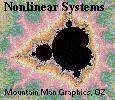 |
|---|

| Selected Book Reviews
and Resources onNonLinear Systems
The Fractal Geometry of Nature
by
Benoit B. Mandelbrot (1977)
|
|---|
|
|---|
|
|---|
"Fractal is a word invented by Mandelbrot
to bring together under one heading a large class of
objects that have [played] ... an historical role ...
in the development of pure mathematics.
A great revolution of ideas separates the classical
mathematics of the 19th century from the modern mathematics
of the 20th. Classical mathematics had its roots in the
regular geometric structures of Euclid and the
continuously evolving dynamics of Newton.
Modern mathematics began with Cantor's set theory and
Peano's space filling curve. Historically, the revolution
was forced by the discovery of mathematical structures
that did not fit the patterns of Euclid and Newton.
These new structures were regarded ... as ... 'pathological,'
... as a 'gallery of monsters,' akin to the cubist painting
and atonal music that were upsetting the established
standards of taste in the arts at about the same time.
The mathematicians who created the monsters regarded them
as important in showing that the world of pure mathematics
contains a richness of possibilities going far beyond the
simple structures that they saw in nature. Twentieth
century mathematics flowered in the belief that it had
transcended completely the limitations imposed by its
natural origins.
Now, as Mandelbrot points out ... Nature has played a
joke on the mathematicians. The 19th century mathematicians
may have been lacking in imagination but Nature was not.
The same pathological structures that the mathematicians
invented to break loose from 19th century naturalism
turns out to be inherent in familiar objects all
around us."
---- Freeman Dyson,
"Characterising Irregularity",
Science, May 1978
Fractal Geometry - Mandelbrot |
|---|
"Fractal geometry is a new branch .[of mathematics].
born belatedly out of the crisis of mathematics that
started when duBois Reymond 1875 first reported on a
continuous nondifferentiable function constructed by
Weierstrass.
The crisis lasted until approximately to 1925, major
actors being Cantor, Peano, Lebesgue, and Hausdorff.
These names, and those of Besicovitch, Bolzano,
Cesaro, Koch, Osgood, Sierpinski, and Urysohn, are
not ordinarily encountered in the empirical study of
Nature, but I claim that the impact of the work of
these giants far transcends its intended scope."
--- Mandelbrot, "Fractal Geometry of Nature", 1977
Non-Linear Index |
Mountain Man Graphics |
E-Mail






